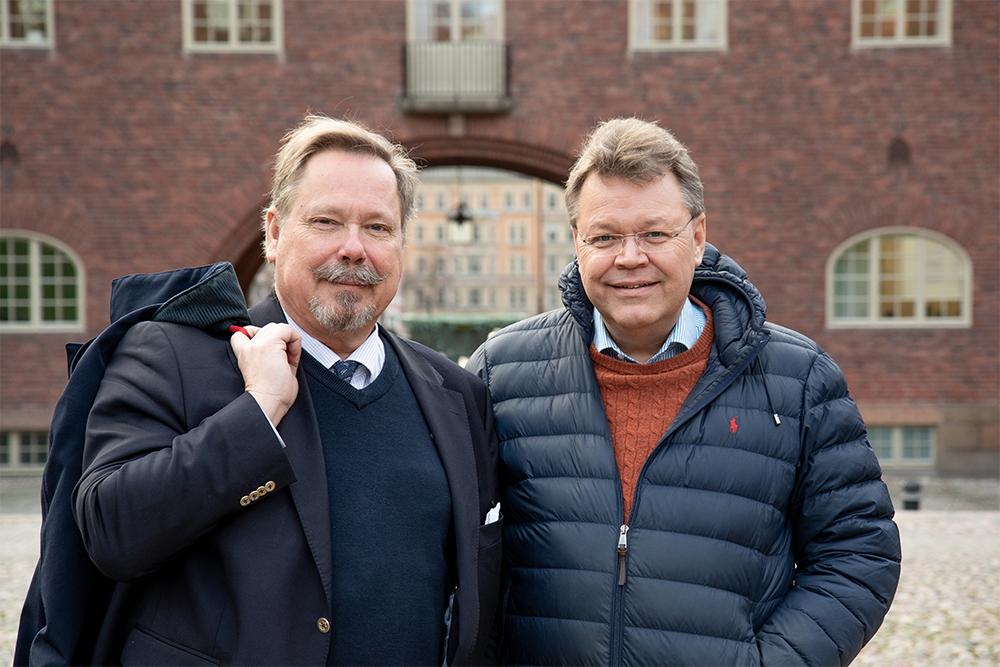KTH technology aims to drastically reduce CO2 emissions from the steel industry

With a method using gasified biomass, this team wants to reduce CO2 emissions from steel production with up to 100 times.
- We hope our method can contribute to solving the problem of CO2 emissions from the steel industry, says Peter Samuelsson, co-founder of KTH spinoff FerroSilva.
Reducing emissions from the steel industry is a key issue for Sweden to reach climate neutrality by 2045. The answer needs to come in a range of solutions says Rutger Gyllenram and Peter Samuelsson, who won the KTH Innovation Challenge: Going Climate Neutral for their idea FerroSilva, the Iron Forest.
Reducing CO2 emissions
Traditional production of steel from iron ore emits about two kilograms of CO2 per kilogram of steel. A way of reducing emissions is using scrap metal in one step of the process, but that method has its limitations, for example in access to iron raw materials with low levels of impurities. In their project, Peter Samuelsson and Rutger Gyllenram will instead develop a process using reduction gas produced from biomass, so called syngas. The gas can then be used to produce direct-reduced iron, or DRI, cutting the need to use fossil fuels from the process. This way, they can reduce the emission of CO2 by as much as 100 times. This method of producing DRI is already being used today, but usually with fossil natural gas instead of syngas.
Seeing as natural gas is expensive in Sweden, while we at the same time have plenty of resources in the form of biomass and iron ore, the researchers’ initial calculations show that this method cost about as much as the methods in use today.
- Some say that we don’t have enough biomass in Sweden, but fact is that even if we produced all steel in Sweden using our method, we would only use 10% of the biomass that we use for energy purposes today. If we start using the available biomass more efficiently, the production methods can also increase, says Peter Samuelsson.
Could create a carbon sink
Since FerroSilva’s technology is also suitable for carbon capture, it could not only lower emissions but also become a carbon sink. The project builds on established and relatively well-known technologies and processes, which is one if its strengths, says Peter Samuelsson.
- Striving to find something new and exciting is very human behavior. The advantage of our project is that it builds on established technology, which lowers the risk. Our greatest challenge will be integrating the processes to create the highest possible efficiency, and that will definitely be hard enough.
Building on established processes
Both Peter Samuelsson and Rutger Gyllenram started at their careers at KTH as students in Mining Engineering, and have been teaching and conducting research at KTH since, combined with working in industry. Already in the 80's, Rutger Gyllenram was analyzing process proposals in the steel industry.
- This was after the energy crisis in the 70’s. We got masses of brilliant proposals, but in the end very few of them were ever implemented. That’s why we want to build on something that’s already established. Starting from scratch is very hard.
With new energy for their project
Up until now, Peter Samuelsson and Rutger Gyllenram have been in charge of the development of the process concept, and of evaluating the technical and economic aspects, often in discussion with colleagues at the Institution of Materials Science and Engineering . The team has been working on FerroSilva for a few years, but mean that after winning the KTH Innovation Challenge, they feel filled with new energy.
- As an entrepreneur and inventor, you constantly doubt your abilities and question if you’re focusing on the right thing. KTH Innovation is very important in that process, says Rutger Gyllenram, who first used KTH Innovation’s support already ten years ago in another project.
Next steps
The team wins 100 000 SEK in proof-of-concept funding, which they plan on using for a pre-study looking at supply and properties of different kinds of biomass and how well it’s suited for gasification, before they move on to apply for more project funding from other sources. They are looking to involve students, researchers and research students at KTH in the work.
- Winning the challenge and getting continued support from KTH Innovation is a great opportunity for us, says Peter Samuelsson. We’ll be able to develop faster now that we can also include other researchers in our project, and that has really boosted our energy.
The long-term plan is for FerroSilva to open their first industrial plant by the end of the 20’s. Do you want to know more or engage in the project? Contact Peter Samuelsson at petersam@kth.se .